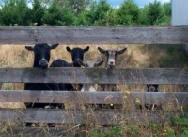

To send a message to an author, click on the author's name at the end of the article.
This Month in Ag Connection | Ag Connection - Other Issues Online
A high priority for many farm families and other business owners is the preservation of the family business for succeeding generations. A topic of increasing interest and importance is risk management associated with long-term disability or elder care. The Deficit Reduction Act of 2005, signed into law this February, has significantly changed the planning strategies for Medicaid and long-term health care.

Two of the most significant changes involve Medicaid's "lookback" period and the penalty period calculation. Most people realize a penalty period exists for gifts made within three years of applying for Medicaid. The new law extends the lookback period from three years to five years and changes the starting date of the penalty period.
The penalty period is calculated by dividing the value of the gifts within the lookback period by the published average monthly cost of nursing home care in Missouri. Under prior law, the penalty period started at the date the gift is given. As a result, many penalty periods ended prior to the application for Medicaid. Under the new law, the penalty period will not start until the date the transferor enters the nursing home and would otherwise be eligible for Medicaid coverage.
Elder and long-term care planning has always been an important component of business and estate planning; however, if substantial gifting is a component of your business estate planning - elder and long-term care planning just got more important.
(Author: Parman R. Green, Ag Business Management Specialist)
This Month in Ag Connection | Ag Connection - Other Issues Online

Fencing for small livestock may involve both fencing them in and fencing out predators. I am copying some information from several states in regard to fencing for animals such as sheep and goats. Sheep and goats should probably not be discussed in the same article as the requirements vary greatly. In the Ohio State University Fact Sheet on Meat Goat and Budgeting we find that goats require very tight fencing. Net fencing, traditional woven wire with two to three barbed wires above it, eight-strand high-tensile fence with electrified third, fifth and top wire have all proven to be effective fencing.
Good fencing protects and confines valuable livestock by presenting barriers to restrict animal movement. Barriers may be physical, psychological or a combination of both. Physical barriers consist of enough materials of sufficient strength to prevent or discourage animals from going over, under or through the fence. Psychological barriers depend upon using negative stimulation to discourage animals from challenging a physical barrier of inferior strength.
The following information on sheep and goat fencing is found in Fencing Materials for Livestock Systems, a Virginia Cooperative Extension publication. Barbed wire fences have typically been used for sheep and goats. However, these fences are not recommended for sheep since barbs pull the fleece. Furthermore, barbed wire fences do not effectively confine goats if moderate grazing pressure is applied to the fenced-in area.
Heavy or extra-heavyweight woven wire fences are excellent for non-horned sheep and goats. Fence height should be at least 39 inches high to prevent animals from climbing over the fence; however, fence height depends upon the breed to be confined. Mesh wire fences also make excellent fences for non-horned sheep and goats. Temporary fencing is not recommended for sheep or goats since they can easily escape.
Special consideration must be given to fencing for horned sheep and goats. Fencing should prevent horned sheep and goats from placing their heads on the other side of the fence or should have openings that are large enough to let animals slide their head through the fence and back. Permanent electric fences also make good fences for horned goats and sheep.
Predator control is another important consideration for sheep and goat fencing. Five-strand high tensile electric fence is particularly useful for discouraging predators such as dogs and coyotes. However, fences must be kept free of vegetation to maintain electric current on the fence.
Woven wire fencing is excellent for predator control. One strand of high tensile electric wire can be used at the bottom of a woven wire fence for predator control. If electric wire is not used, the fence bottom should be placed on the ground to allow for the use of snares where predators dig under the fence. At least one manufacturer makes woven wire fencing with stay wires attached to line wires with a fixed knot. This prevents predators from sliding apart the stay wires and entering the confined area.
Coyotes can pass through openings as small as 4.5 inches. Woven wire fences with stay wires spaced close together can prevent predators from entering fenced-in areas. Some manufacturers produce fencing with bottom openings of 6 inch by 3 inch for predator control and 3 inch by 3 inch for predator proofing.
UMC Guide G3990 - Feeding and Housing Dairy Goats; recommends the following: Fences serve two purposes that make them an important part of a housing plan -- they keep goats in and dogs out. They also keep foraging goats away from your trees and shrubs as well as your neighbor's flower patch. Set 7-foot posts, either wooden or steel, on 12-foot centers. Then use either a 4-foot-high woven wire fence topped with an electric wire 12 inches above the woven wire or use a completely electric fence. If you use a completely electric fence, place the first wire 12 inches from the ground, then four more wires on 6-inch spacings to a total height of 36 inches. Use insulators on the post to attach the wires. The electric fence works well when weeds, grass and brush are not allowed to touch the wires and short it out or when the ground isn't bone dry during periods of drought. Your local farm supply store can recommend the proper equipment. The guide can be found at: http://extension.missouri.edu/publications/DisplayPub.aspx?P=G3990
For some interesting reading about the habits of goats, see the Meat Goat Production Handbook. It has a section on housing, fencing, working facilities and predators. Lynn Harwell and Frank Pinkerton have a down home way of describing the challenges of keeping goats in. You can find this publication at: http://www.clemson.edu/agronomy/goats/handbook/housing.html
The following are useful references in planning fencing systems:
(Author: Don Day, Natural Resource Engineer)
This Month in Ag Connection | Ag Connection - Other Issues Online
Recent press releases have caused some concern about the need to track hay and grain sold off the farm relative to the Public Health Security and Bioterrorism Preparedness and Response Act of 2002. The requirements took effect on June 9 for operations with more than 10 employees, and will take effect on December 9 for all other operations. The Food and Drug Administrations (FDA) requirements are stated in a fact sheet at: http://www.cfsan.fda.gov/~dms/fsbtac23.html.
The National Hay Association and others have checked with the FDA and have found that the recording requirements have been vastly overstated in the press. According to the requirements, producers should keep track of who/where commodities are bought from and who/where commodities are sold.
Farms are specifically exempt. FDA is proposing to define "farm" in Sec. 1.227(c)(3) in part as "a facility in one general physical location devoted to the growing of crops for food, the raising of animals for food (including seafood), or both. ...Some examples of farms include: apple orchards, hog farms, dairy farms, feedlots or aquaculture facilities." The definition of farm includes: "(i) Facilities that pack or hold food, provided that all of the food used in such activities is grown or raised on that farm or is consumed on that farm; and (ii) facilities that manufacture/process food, if all of the food used in such activities is consumed on that farm or another farm under the same ownership. ... Facilities that engage in manufacturing/processing, packing or holding of food that are not described in the definition of "farm'' must register. ... A farm that manufactures/processes, packs, or holds food is not required to register with FDA if all of the food used in such activities is consumed on that farm or another farm under the same ownership. For example, a farm that manufactures or processes animal feed from ingredients obtained off the farm for consumption by animals on the farm would be exempt because most farms that raise animals engage in this activity."
Farmers who simply bale hay for sale do not have to register their facilities or maintain records. The FDA does not consider baling hay as processing. All the FDA needs is a receipt, contained in a receipt book, showing the name of the person (or entity) that bought the hay, in addition to listing the quantity that was purchased. There is no requirement that hay producers keep track of all the bales and where they go. Records that are maintained for tax purposes which show that a sale was made, and to whom the sale was made, should be sufficient for compliance. The new FDA rule will not require a farmer to change recordkeeping as long as details of the feed sale are recorded.
Drying hay or grain and chopping for silage are considered post-harvest activities, which would be considered manufacturing or processing; therefore, a facility drying hay or grain or chopping forage must establish and maintain records of the food's receipt (if purchased) and release (if sold) as required in 21 CFR 1.337 and 1.345. Those selling silage would fall under this requirement.
In particular, there is no need for being able to track lots of hay or grain back to individual fields as some have indicated. Thus, the news releases have been much ado about nothing. No additional records for hay or grain sales are required beyond what most keep for tax records.
(Author: Dan Undersander, University of Wisconsin, phone: 608-263-5070 or email at djunders@wisc.edu.)
This Month in Ag Connection | Ag Connection - Other Issues Online
(Author: Dr. Tim Safranski, University of Missouri Extension State Swine Specialist)
This Month in Ag Connection | Ag Connection - Other Issues Online
Physical, environmental, nutritional and social stresses commonly impact calves at weaning. Traditional weaning systems typically stack two or more of the stressors together and cause problems with reduced calf health and performance.
When designing weaning programs to reduce the number of stressors occurring at once, consider the following:
(Author: Mark Stewart, Livestock Specialist)
This Month in Ag Connection | Ag Connection - Other Issues Online
Publishing Information
Ag Connection is published monthly for Northeast and Central areas of Missouri producers and is supported by the University of Missouri Extension, the Missouri Agricultural Experiment Station, and the MU College of Agriculture, Food and Natural Resources. Managing Editor: Mary Sobba.